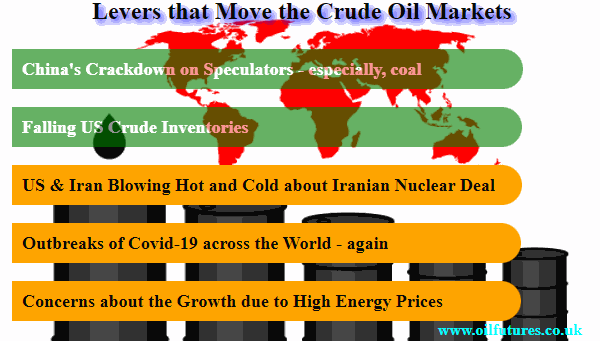Although the price of crude oil went slightly down
this week, having reached a seven-year-high value, analysts do not anticipate a
precipitous fall in the coming weeks, especially when the winter is on the
horizon as far as many industrialized nations are concerned.
As of 18:00 GMT on Friday, the two main benchmarks,
WTI and Brent, stood at $84 and $84 respectively, slightly lower than what they
were, a week ago.
The seed for the sudden occurrence of an energy
crunch was the cumulative global anxiety over the supply of fuel for power
plants. As the wind turbines could not provide the power expected of them in ‘windless’
summer, power companies started to run helter-skelter in search of substitutes
to generate power.
During the pandemonium, there was not enough coal in
stock, having been pilloried as the worst of all fossil fuels. Since the demand
far outweighed supply, power companies turned to gas as an alternative that in
turn caused a massive rise in gas prices, with the gap between demand and
supply widening alarmingly.
When the calamitous spectacle of coal and gas
shortages played out in the markets, analysts feared the worst – lack of fossil
fuels to power up generators, across the world. In these circumstances, as
exactly anticipated, the inevitable happened with the price of crude oil hitting
a record high.
The energy mystery, meanwhile, kept deepening when
all that took place in the midst of crude inventories of the world’s top consumer,
the US, consistently grew, defying the forecasts of seasoned analysts.
Then, all of a sudden the price of crude oil, along
with other commodities, fell at the news that China, the world’s second largest
consumer of crude oil, started coming down hard on speculators of coal futures.
Not only did China resort to clamping down what it calls, commodity
manipulators, but also raided coal storage facilities to catch those who hoard.
As far as the Chinese officials are concerned, it
worked in their favour: the price of coal substantially fell in the Chinese
markets, before spilling over to the other regions too; in addition, the coal
inventories have grown substantially in recent days, in some power plants the
figure exceeding 100 million tons at present.
Although China managed the coal crisis successfully
with the strong arm tactics, the sudden demand for the commodity has
inadvertently created yet another headache for the authorities.
With the growth of coal inventories, the demand for
the commodity has resulted in a boom for the transport companies. As a result,
certain fuel stations in North China have run out of diesel; the tendency of
manufactures turning to diesel in order to generate power has not been
conducive in diffusing the crisis.
The power crisis that China faced in the last few
weeks appears to be much more serious than what the West estimated, in terms of
its scope and potential consequences.
The reported shortage of magnesium is a case in
point; magnesium, a metal widely used in a number of vital industries, is in
short supply at present owing to global supply chain disruptions; China
produces about 75% of global aluminium supply and 90% of European needs come
from China, according to some Chinese media.
The same media sources blame it on the power
shortages and recently-announced carbon emission targets. The production
process of the metal is said to be consuming a lot of power per ton.
The shortage of magnesium emerged when electronic
sectors across the world suffer from acute shortage of silicon chips; most car
plants in the world are unable to function in full capacity due to the
lingering problem.
With the debate over carbon-emissions under an
intense global spot light, the power producers have been forced to walk the
tight rope without letting the world plunge into darkness.
The ordinary consumers, meanwhile, are paying the
price for the combination of years of policy miscalculations and unrealistic
targets, as a colder winter sets its sight on those who live in the northern
hemisphere.
In these circumstances, the policy makers will be
compelled to emulate the pendulum of net zero target that currently oscillates
between 2050 and 2060, instead of staying static – reacting to the ground
realities rather than sticking to rigid energy policies.







